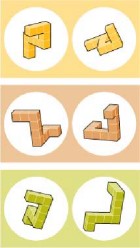
same (rotation in picture-plane)
same (rotation in depth)
different (no rotation possible)
1. What is the basis of the analog coding approach to imagery? Describe the evidence to support this view.
2. What is the basis of the propositional coding approach? Describe the evidence to support this view.
3. What is the basis of Paivio’s Dual Coding Theory? Describe the evidence to support this view.
4. What are metrical and structural properties of cognitive maps? Describe the heuristics applied to cognitive maps.
5. What differences are their in male and female wayfinding?
6. What is eidetic memory?
7. Describe six mnemonic devices that can improve memory.
Imagery: mental representation of stimuli (objects, events) that are not physically present
What is the nature of the representation?
• analogical (“_________”)
• propositional (“___________”)
• multiple coding
(Roger Shepard, Stephen Kosslyn)
Metaphor:
- imagery = perception
- images retain some sensory qualities; are pictorial
Processes:
- generation: images reconstructed from ___ stores
- retention: images are maintained in ___
- inspection: generated images can be _______ by “mind’s eye”
- transformation: mental images can be manipulated like ____ objects
Evidence:
Shepard & Metzler (1971): ________
- same/different task using pairs of “3-D” objects:
 |
same (rotation in picture-plane) |
same (rotation in depth) |
|
different (no rotation possible) |
- RT to decide “same” is a ______ function of angle of rotation:
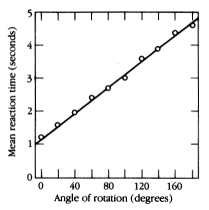
- RT for rotation in depth comparable to RT for rotation in picture-plane
Kosslyn (1975): ____
- imagine a ______ next to (a) a fly or (b) an elephant
- participants asked “Does a rabbit have ears?”
- RT 211 ms longer when target was beside ______ animal; participants reported that the size of “imagined” rabbit was smaller
- possible confounding produced by ________ level
- imagine target beside (a) _____ fly or (b) ____ elephant
- longer RT when target beside larger animal
Kosslyn, Ball, & Reiser (1978): ________
- participants memorized map:
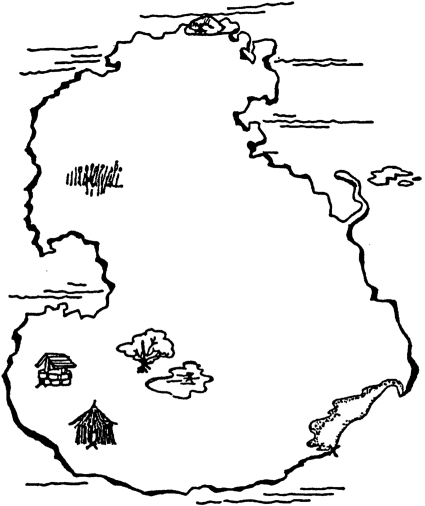
- task: scan from one location to another, and press a button when destination reached
- results:
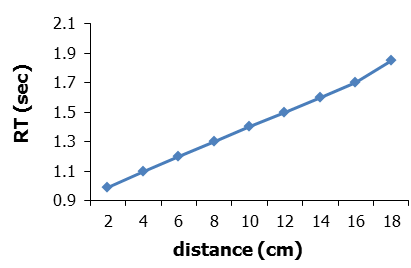
- time to scan between imagined objects correlates with ________ between those objects on a map
Kosslyn (1973): distance
- participants shown drawing:
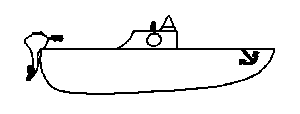
- visualized it from memory, and focused on one ___
- was a named component in the drawing?
e.g., “motor” or “porthole” or “anchor”
- named object farther from place of focus ![]() ______ RTs
______ RTs
- lag time implied ____ of mental image
Roland & Friberg (1985): physiological evidence
- measured regional cerebral blood flow while participants:
• performed mental arithmetic
• thought of a musical jingle
• visually imaged a walk through their neighbourhood
- results: increased cerebral blood flow in some areas of the visual cortex--only with _______ task
(Zenon Pylyshyn, 1973, 2006; Peter Slezak, 1995)
- uses metaphor of ________, not perception
- images are represented by abstract, symbolic, “descriptions” of visual scenes
- ___________: smallest piece of information that can be judged true or false
e.g., “The dog is brown.” has 1
“The small dog is brown.” has 2
- propositions formed by connections between nodes of a network:
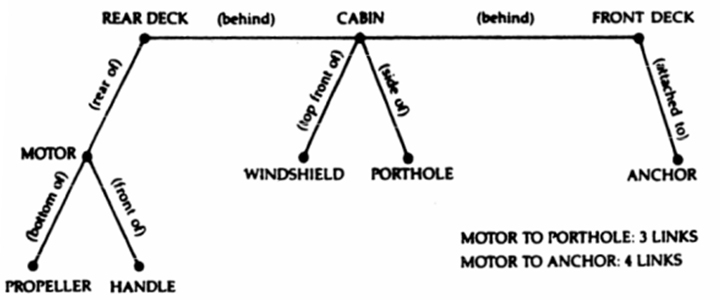
- mind represents concepts; may form images as an epiphenomenal __-_______
e.g., book represents information in words, which generate images when read
Evidence:
- certain operations possible for real images are not possible for mental images
e.g., ______ or negative images of faces (Phillips, 1972)
e.g., rotation of images (Slezak, 1991)
- images are limited
Nickerson & Adams (1979):
- showed 15 “_______”, including an unmodified one
- most people (84%) could not identify the real _____
- images must be lacking in details
- experimenter expectancy, demand characteristics, and participants’ ____________ may be influencing results
• predictions of scanning time across island matched “mental scanning” (Mitchell & Richman, 1980)
• but this breaks down when predictions more difficult (scanning along a spiral vs. straight line)
- ____-_____ relationships: finding particular shapes in a whole figure ![]() chance level (Reed, 1974)
chance level (Reed, 1974)
- semantic (verbal) information may _______ recall of visual images
Carmichael, Hogan, & Walter (1932):
- name given to ambiguous figure affected remembering
Dual Coding Theory (Allan Paivio, 1986; 2006)
- developed as a general theory of cognition
Storage: two independent but interacting systems:
• _______ system: stores images (“_______”); right hemisphere processing
• ______ system: stores linguistic information or verbal descriptions (“________”); left hemisphere processing
Processing: in one or both systems:
• pictures: image processing; may also be labelled (verbal processing)
• concrete words: verbal processing; image may also be formed
• abstract words: verbal processing only
Connections:
• a concept is _________ to other related concepts in the same system (associative connections), and the other system (referential connections)
• activating any one concept also leads to activation of closely related concepts
Pros & cons:
![]() Paivio & Csapo (1969): experimental support
Paivio & Csapo (1969): experimental support
- stimuli: pictures, concrete words, and abstract words
- varied rate of presentation:
• fast = 5.3 items/s (limits participants to one code)
• slow = 2 items/s (opportunity for ____ codes)
- results on free recall task:
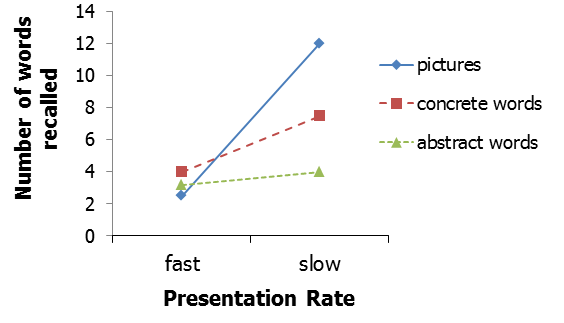
- two codes ________ likelihood of later retrieval
- imagen system superior to logogen system
![]() Kounios & Holcomb (1994): EEG evidence
Kounios & Holcomb (1994): EEG evidence
- concrete words elicited greater activity than abstract words (dual coding)
- concrete words activated both hemispheres equally (dual coding)
- abstract words activated the left hemisphere more than the right (single code)
![]() criticism: there is no need for two representational systems; all memories are stored one way (______ ______ theory)
criticism: there is no need for two representational systems; all memories are stored one way (______ ______ theory)
Can using multiple coding _________ with memory?
Schooler & Engstler-Schooler (1990):
- procedure: participants shown videotaped robbery (creates visual memory)
- task:
• _______ the robber
• ________ the robber
• do a series of math problems
- then given recognition memory test (pick robber out of line-up of 8 people)
- results:
Task: |
Recognition: |
imagine |
55% |
describe |
15% |
math |
42% |
- verbal overshadowing effect: verbalizing previously seen visual stimuli __________ with the original visual memory
Have both metrical and structural components
• metrical: includes information about distances and directions; three types of knowledge:
- ________: information about particular features at a location
- _____-____: specific pathways for moving from one location to another
- ______: estimated distances between landmarks
• structural: includes information about regions and clusters
Hirtle & Jonides (1985):
- distance between landmarks judged
- members of the same cluster judged to be closer than any member of another cluster
e.g., Is it farther to Chapters in St. Albert or 99 Ave./170 St.?
Milgram & Jodelet (1976):
- asked 215 Parisians to draw a map of the Seine river
- over 90% drew it __________ than it actually is
- cognitive maps do not always correspond to physical locations
Barbara Tversky (1981, 1993):
- when navigating space, people use __________: methods that sometimes lead to a correct solution, but often oversimplify reality
e.g., Which is farther north, Rome or Philadelphia?
• _______ heuristic: greater number of landmarks on a route makes it seem longer
• ________ heuristic: representing shapes as more symmetrical than they actually are
• _____-_____ bias: representing intersections as forming 90° angles more than the angles actually do
• ________ heuristic: representing a single slanted figure or boundary as more vertical or horizontal then it actually is
• _________ heuristic: representing several geographical features as more lined up with each other than they really are
Why does our navigational fallibility persist?
Likely because we don’t often encounter ________ about our geographical or travel-time inaccuracy.
Cornell, Sorenson, & Mio (2003):
- measured self-reports of “sense of direction” (SOD)
- also assessed wayfinding:
• pointing to nonvisible _________
• _________ a route with a detour
• devising a ________
• locate site within a building
- found small-moderate correlations between these and ___
• ______ for past performance ![]() SOD
SOD
- compared genders:
• males predominantly used ______ knowledge: based on comparisons among landmarks; like bird’s eye view
• females relied on _____ knowledge: based on a series of directions; like “vectors”
- females rated their SOD as _____ than males, but no gender differences obtained in ______ wayfinding
- problems may arise if typical ____ is given route knowledge, or if typical ______ is survey knowledge
- definition: detailed, vivid recollections of a complex visual scene; a.k.a. “____________ memory”
Haber & Haber (1964, 1988):
- tested elementary school age children, aged 7-12
- showed pictures on an easel for 30 s, then removed them and asked questions about them
- 8% of children performed significantly differently from the rest
- criteria for eidetic memory: images...
• must be reported
• must be positively coloured (not negative image)
• are projected onto space (not just “in the head”)
• described in the _______ tense
• associated with eye movements appropriate to the location of objects in the scene
- images lasted at least 40 s
- this ability is equally likely in males and females, but is less common in ______
Stromeyer & Psotka (1970):
- case study of eideteker named Elizabeth
- could reproduce a poem written in a foreign language that she did not understand, from bottom to top, as fast as she could write--even years later
- could fuse two-part random dot patterns, each containing _________ dots, presented 4 hours apart
- could also fuse two patterns presented a day apart into stereoscopic images
- however, no one else has passed such a test, Elizabeth refused to repeat any tests, and ended up ________ Stromeyer
Miller & Peacock (1982):
- compared eidetic 12-14 year old boys to control group
eidetic |
control |
|
recall of picture details: |
6.3 |
4.9 |
dot fusion (number correct out of 18) |
13 |
3 |
- eidetic more susceptible to ____________ from a second stimulus than controls
- eidetic memories lasted longer (25-180 s) than images of control group (0-13 s)
Conclusions:
- relatively rare ability to maintain vivid, detailed images; etiology unknown
- quantitatively and qualitatively _________ from non-eidetic memory
- not really “photographic memory”:
• recall far from _______
• memories ____ in a few minutes
• images easily disrupted by new visual stimulation
- definition: techniques to aid memory, often by visually associating to-be-remembered items with a known series of images
- in an anecdotal story, the poet Simonides of Ceos (c. 500 BC) was said to have escaped a collapsing feast hall; he later identified the victims by imagining where they were sitting
Kinds of mnemonics:
• method of ____: associate to-be-recalled items with familiar locations (a “memory palace” or “Roman room”)
• ___ ____ system: associate items with “pegs”
e.g., 1 is a bun, 2 is a shoe, 3 is a tree, etc.
• ___ ____: connect sound of word with familiar word
e.g., pato (Spanish for “duck”) pronounced “pot-oh,” so picture a duck wearing a pot
• ____________: hierarchically, or story, or rhyme
e.g., chunking
• _______: use first letter of each word to create pronounceable word
e.g. POLKA (=Pegword, etc...)
• ________: use phrase made with first letters
e.g., Pa Observed Lice Kissing Ants
Why do mnemonics work?
• provide structure for encoding and cues for retrieval
• apply multiple codes (verbal and imagery)
• form vivid, durable trace less subject to ____________